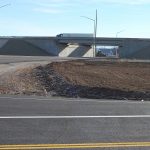Development of a Specification for Quality Acceptance of Chip Seals Using a Laser Texture Scanner
|
Chip seals are widely used in Washington state as a cost-effective pavement surfacing method. However, they can be subject to variations in performance and premature failures. This project developed a quality acceptance specification for chip seal construction that incorporates the use of a laser texture scanner to provide valuable, data-driven insights for quality control and performance assessment to enhance the quality and effectiveness of chip seals. ... Read More about Development of a Specification for Quality Acceptance of Chip Seals Using a Laser Texture Scanner | |










